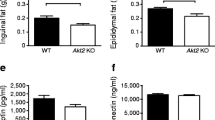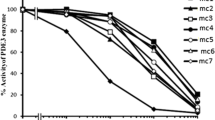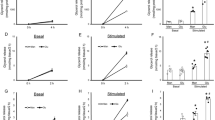Summary
Acipimox is commonly used to treat hyper-triglyceridaemia in non-insulin-dependent diabetic patients, but its precise mechanism of action has yet to be elucidated. We examined the in vitro effects of acipimox on the lipolytic regulatory cascade in epididymal adipocytes isolated from Wistar rats. Acipimox inhibited the lipolytic rate stimulated by adenosine deaminase (1 U/ml) in a concentration-dependent manner, reaching a near-basal value at 10 Μmol/l acipimox. Lipolysis activated by sub-maximal levels of isoproterenol in combination with adenosine deaminase (20 mU/ml) was significantly (p<0.05) decreased by 100 Μmol/l acipimox, whereas, in the absence of adenosine deaminase, 100 Μmol/l acipimox showed no significant (p>0.05) inhibition. These findings suggested that the anti-lipolytic mechanism regulated by adenosine may also be regulated by acipimox. Acipimox diminished the intracellular cyclic AMP level produced by 25 nmol/l isoproterenol in the presence of adenosine deaminase (20 mU/ml) in a concentration-dependent manner. At the same level of stimulation, acipimox inhibited the cyclic AMP-dependent protein kinase activity ratio and lipolytic rate over the same concentration range, with significant (p<0.05) reductions occurring at and above, 0.5 Μmol/l and 10 Μmol/l acipimox, respectively. Western blotting showed that upon lipolytic stimulation (1 U/ml adenosine deaminase; 100 nmol/l isoproterenol) a threefold increase in the lipolytic rate was accompanied by a significant (p<0.05) rise in hormone-sensitive lipase associated with the lipid fraction. Acipimox (1 mmol/l) and insulin (1 nmol/l) re-distributed hormone-sensitive lipase back to the cytosol, with a corresponding significant (p<0.05) loss from the fat cake fraction of adipocyte homogenates. In conclusion, the anti-lipolytic action of acipimox is mediated through suppression of intracellular cyclic AMP levels, with the subsequent decrease in cyclic AMP-dependent protein kinase activity, leading to the reduced association of hormone-sensitive lipase with triacylglycerol substrate in the lipid droplet of adipocytes.
Similar content being viewed by others
Abbreviations
- NIDDM:
-
Non-insulin-dependent diabetes mel-litus
- HSL:
-
hormone-sensitive lipase
- cAMP:
-
adenosine 3′∶5′-cyclic monophosphate
- A-kinase:
-
cyclic AMP-dependent protein kinase
- DTT:
-
dithiothreitol
- PIA:
-
N6-[R-(−)-1-methyl-2-phenethyl]-adenosine
- Hepes:
-
4-(2-hydroxyethyl)-1-piperazi-neethanesulphonic acid
- BSA:
-
bovine serum albumin
- PCV:
-
packed cell volume
- Ro 20-1724:
-
4-(3-butoxy-4-methoxybenzyl)-2-imidazolidinone
- MOPS:
-
3-(N-morpholino) propanesulphonic acid
- ADA:
-
adenosine deaminase
- NEFA:
-
non-esterified fatty acids
- KRH:
-
Krebs-Ringer-Hepes
- TCA:
-
trichloroacetic acid
- PBS:
-
phosphate buffered saline
- IC50 :
-
half-maximal inhibition
References
Howard BV (1987) Lipoprotein metabolism in diabetes mellitus. J Lipid Res 28: 613–628
Study Group, European Atherosclerosis Society (1988) The regulation and management of hyperlipidaemia in adults: a policy statement of the European Atherosclerosis Society. Eur Heart Journal 9: 571–600
Tornvall P, Walldius GW (1991) A comparison between nicotinic acid and acipimox in hypertriglyceridaemia — effects on serum lipids, lipoproteins, glucose tolerance and toler-ability. J Int Med 230: 415–421
Sirtori CR, Gianfranceschi G, Sirtori M et al. (1981) Reduced triglyceridaemia and increased high density lipoprotein cholesterol levels after treatment with acipimox, a new inhibitor of lipolysis. Atherosclerosis 38: 267–271
Stuyt PMJ, Stalenhoef AFH, Demacker PNM, Van't Laar A (1985) A comparative study of the effects of acipimox and clofibrate in type III and type IV hyperlipoproteinaemia. Atherosclerosis 55: 51–62
Ball MJ, Vella M, Reckless JPD et al. (1986) Acipimox in the treatment of patients with hyperlipidaemia: a double blind trial. Eur J Clin Pharmacol 31: 201–204
Crepaldi G, Avogaro P, Descovich GC et al. (1988) Plasma lipid lowering activity of acipimox in patients with type II and type IV hyperlipoproteinaemia: Results of a multicentre trial. Atherosclerosis 70: 115–121
Lovisolo PP, Briatco-Vangosa G, Orsini G, Ronchi R, Angelucci R, Valzelli G (1981) Pharmacological profile of a new anti-lipolytic agent: 5-methyl-pyrazine-2-carboxylic acid 4-oxide (acipimox) I. Mechanism of action. Pharmacological Res Comm 13: 151–161
Stirling C, McAleer M, Reckless JPD et al. (1985) Effects of acipimox, a nicotinic acid derivative, on lipolysis in human adipose tissue and on cholesterol synthesis in human jejunal mucosa. Clin Sci 68: 83–88
Reaven GM, Hollenbeck C, Jeng C-Y, Wu MS, Chen Y-D I (1988) Measurement of plasma free fatty acid, lactate and insulin for 24 h in patients with NIDDM. Diabetes 37: 1020–1024
Randle PJ, Garland PB, Hales CN, Newsholme EA (1963) The glucose fatty-acid cycle: its role in insulin sensitivity and the metabolic disturbances in diabetes mellitus. Lancet I:785–789
Fulcher GR, Walker M, Catalano C, Agius L, Alberti KGMM (1992) Metabolic effects of suppression of non-esterified fatty acid levels with acipimox in obese NIDDM subjects. Diabetes 41: 1400–1408
Yeaman SJ (1990) Hormone-sensitive lipase — a multipurpose enzyme in lipid metabolism. Biochim Biophys Acta 1052: 128–132
Fain JN, Malbon CC (1979) Regulation of adenylate cyclase by adenosine. Mol Cell Biochem 25: 143–169
Moreno FJ, Shepherd RE, Fain JN (1979) Effect of NAD, nicotinamide and nicotinic acid on cyclic AMP accumulation by fat cells. Naunyn-Schmiedebergs Arch Pharmacol 306: 179–183
Kather H, Simon B (1979) Biphasic effects of prostaglandin E2 on human fat cell adenylate cyclase. J Clin Invest 64: 609–612
Fain JN (1980) Hormonal regulation of lipid mobilization from adipose tissue. Biochem Actions Hormones VII:119–204
Stralfors P, Bjorgell P, Belfrage P (1984) Hormonal regulation of hormone-sensitive lipase in intact adipocytes — identification of phosphorylated sites and effects on the phosphorylation by lipolytic hormones and insulin. Proc Natl Acad Sci USA 81: 3317–3321
Smith CJ, Vasta V, Degerman E, Belfrage P, Manganiello VC (1991) Hormone-sensitive cyclic GMP-inhibited cyclic AMP phosphodiesterase in rat adipocytes. J Biol Chem 266: 13385–13390
Illiano G, Cuatrecasas P (1972) Modulation of adenylate cyclase activity in liver and fat cell membranes by insulin. Science 175: 906–908
Londos C, Honnor RC, Dhillon GS (1985) cAMP-dependent protein kinase and lipolysis in rat adipocytes. III. Multiple modes of insulin regulation of lipolysis and regulation of insulin responses by adenylate cyclase regulators. J Biol Chem 260: 15139–15145
Egan JJ, Greenberg AS, Chang M-K, Wek SA, Moos Jr MC, Londos C (1992) Mechanism of hormone-stimulated lipolysis in adipocytes: translocation of hormone-sensitive lipase to the lipid storage droplet. Proc Natl Acad Sci USA 89: 8537–8541
Cheng H-C, Kemp BE, Pearson RB et al. (1986) A potent synthetic peptide inhibitor of the cAMP-dependent protein kinase. J Biol Chem 261: 989–992
Kraemer FB, Patel S, Saedi MS, Sztalryd C (1993) Detection of hormone-sensitive lipase in various tissues I. Expression of an HSL/bacterial fusion protein and generation of anti-HSL antibodies. J Lipid Res 34: 663–671
Kather H, Wieland E (1984) Glycerol. Luminometric method. In: Bergmeyer HU (ed) Methods of enzymatic analysis, Vol 6. Verlag Chemie Weinheim, Germany, pp 510–518
Gilman AG (1970) A protein binding assay for adenosine 3′,5′-cyclic monophosphate. Proc Natl Acad Sci USA 67: 305–312
Laemelli UK, Favre M (1973) Maturation of the head of bacteriophage T4. J Mol Biol 80: 575–599
Hales CN, Luzio JP, Siddle K (1978) Hormonal control of adipose tissue lipolysis. Biochem Soc Symp 43: 97–135
Sengupta K, Long KJ, Allen DO (1981) Relationship among isoproterenol, cyclic AMP, cyclic AMP-dependent protein kinase and lipolysis in perfused fat cells. J Pharmacol Exp Ther 218: 128–133
Litosch I, Hudson H, Mills I, Li S-Y, Fain JN (1982) Forskolin as an activator of cyclic AMP accumulation and lipolysis in rat adipocytes. Mol Pharmacol 22: 109–115
Fain JN, Wieser PB (1975) Effects of adenosine deaminase on cyclic adenosine monophosphate accumulation, lipolysis, and glucose metabolism in fat cells. J Biol Chem 250: 1027–1034
Aitchison RED, Clegg RA, Vernon RG (1982) Lipolysis in rat adipocytes during pregnancy and lactation. Biochem J 202: 243–247
Saggerson ED (1986) Sensitivity of adipocyte lipolysis to stimulatory and inhibitory agonists in hypothyroidism and starvation. Biochem J 238: 387–394
Wieser PB, Fain JN (1975) Insulin, prostaglandin E1, phenylisopropyl-adenosine and nicotinic acid as regulators of fat cell metabolism. Endocrinology 96: 1221–1225
Aktories K, Gunter S, Jakobs KH (1981) Na+ amplifies adenosine receptor-mediated inhibition of adipocyte adenylate cyclase. Eur J Pharmacol 71: 157–160
Olansky L, Myers GA, Pohl SL, Hewlett EL (1983) Promotion of lipolysis in rat adipocytes by pertussis toxin: reversal of endogenous inhibition. Proc Natl Acad Sci USA 80: 6547–6551
Aktories K, Jakobs KH, Schultz G (1980) Nicotinic acid inhibits adipocyte adenylate cyclase in a hormone-like manner. FEBS Letts 115: 11–14
Aktories K, Schultz G, Jakobs KH (1980) Regulation of adenylate cyclase in hamster adipocytes. Inhibition by prostaglandins, α-adrenergic agonists and nicotinic acid. Naunyn-Schmiedebergs Arch Pharmacol 312: 167–173
Kather H, Aktories K, Schultz G, Jakobs KH (1983) Islet-activating protein discriminates the antilipolytic mechanism of insulin from that of other antilipolytic compounds. FEBS Letts 161: 149–152
Londos C, Cooper DMF, Rodbell M (1981) Receptor-mediated stimulation and inhibition of adenylate cyclases: the fat cell as a model system. In: Dumont JE, Greengard P, Robison GA (eds) Advances in cyclic nucleotide research, vol 14. Raven Press, New York, pp 163–167
Greenberg AS, Egan JJ, Wek SA, Garty NB, Blanchette-Mackie EJ, Londos C (1991) Perilipin, a major hormonally regulated adipocyte-specific phosphoprotein associated with the periphery of lipid storage droplets. J Biol Chem 266: 11341–11346
Stralfors P, Honnor RC (1989) Insulin-induced dephos-phorylation of hormone-sensitive lipase. Correlation with lipolysis and cAMP-dependent protein kinase activity. Eur J Biochem 182: 379–385
Egan JJ, Greenberg AS, Chang M-K, Londos C (1990) Control of endogenous phosphorylation of the major cAMP-dependent protein kinase substrate in adipocytes by insulin and Β-adrenergic stimulation. J Biol Chem 265: 18769–18775
Musatti L, Maggi E, Moro E, Valzelli G, Tamassia V (1981) Bioavailability and pharmacokinetics in man of acipimox, a new antilipolytic and hypolipemic agent. J Int Med Res 9: 381–386
Author information
Authors and Affiliations
Rights and permissions
About this article
Cite this article
Christie, A.W., McCormick, D.K.T., Emmison, N. et al. Mechanism of anti-lipolytic action of acipimox in isolated rat adipocytes. Diabetologia 39, 45–53 (1996). https://doi.org/10.1007/BF00400412
Received:
Revised:
Issue Date:
DOI: https://doi.org/10.1007/BF00400412




